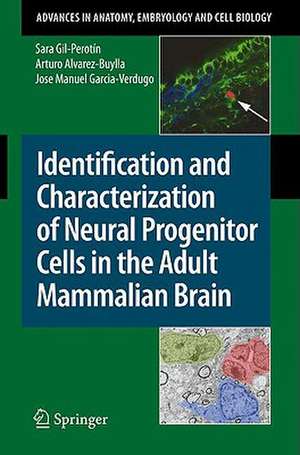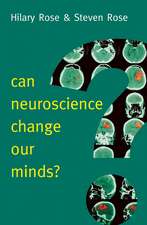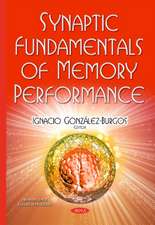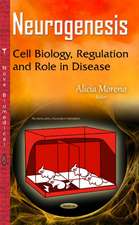Identification and Characterization of Neural Progenitor Cells in the Adult Mammalian Brain: Advances in Anatomy, Embryology and Cell Biology, cartea 203
Autor Sara Gil-Perotín, Arturo Alvarez-Buylla, Jose Manuel Garcia-Verdugoen Limba Engleză Paperback – 30 apr 2009
Din seria Advances in Anatomy, Embryology and Cell Biology
- 5%
 Preț: 1146.33 lei
Preț: 1146.33 lei - 5%
 Preț: 721.19 lei
Preț: 721.19 lei - 15%
 Preț: 637.13 lei
Preț: 637.13 lei -
 Preț: 381.81 lei
Preț: 381.81 lei - 15%
 Preț: 644.95 lei
Preț: 644.95 lei - 5%
 Preț: 1025.16 lei
Preț: 1025.16 lei - 15%
 Preț: 689.97 lei
Preț: 689.97 lei - 15%
 Preț: 577.07 lei
Preț: 577.07 lei - 15%
 Preț: 580.36 lei
Preț: 580.36 lei - 5%
 Preț: 393.51 lei
Preț: 393.51 lei -
 Preț: 408.66 lei
Preț: 408.66 lei -
![Die Schlüpfdrüse der Geburtshelferkröte (Alytes o. obstetricans [LAURENTI]) und anderer Froschlurche](https://i4.books-express.ro/bs/9783662239742/die-schluepfdruese-der-geburtshelferkroete-alytes-o-obstetricans-laurenti-und-anderer-froschlurche.jpg) Preț: 408.27 lei
Preț: 408.27 lei - 5%
 Preț: 1090.61 lei
Preț: 1090.61 lei - 5%
 Preț: 705.11 lei
Preț: 705.11 lei - 5%
 Preț: 706.04 lei
Preț: 706.04 lei - 5%
 Preț: 357.61 lei
Preț: 357.61 lei - 5%
 Preț: 704.59 lei
Preț: 704.59 lei - 5%
 Preț: 705.11 lei
Preț: 705.11 lei - 5%
 Preț: 359.42 lei
Preț: 359.42 lei - 5%
 Preț: 711.52 lei
Preț: 711.52 lei - 15%
 Preț: 635.47 lei
Preț: 635.47 lei - 15%
 Preț: 631.72 lei
Preț: 631.72 lei - 15%
 Preț: 633.35 lei
Preț: 633.35 lei - 15%
 Preț: 632.37 lei
Preț: 632.37 lei - 5%
 Preț: 706.60 lei
Preț: 706.60 lei - 15%
 Preț: 631.07 lei
Preț: 631.07 lei - 5%
 Preț: 707.13 lei
Preț: 707.13 lei - 5%
 Preț: 707.33 lei
Preț: 707.33 lei - 5%
 Preț: 359.60 lei
Preț: 359.60 lei - 5%
 Preț: 707.69 lei
Preț: 707.69 lei - 5%
 Preț: 707.13 lei
Preț: 707.13 lei - 5%
 Preț: 708.06 lei
Preț: 708.06 lei - 5%
 Preț: 706.41 lei
Preț: 706.41 lei - 5%
 Preț: 708.78 lei
Preț: 708.78 lei - 5%
 Preț: 705.68 lei
Preț: 705.68 lei - 5%
 Preț: 705.11 lei
Preț: 705.11 lei - 5%
 Preț: 706.77 lei
Preț: 706.77 lei - 15%
 Preț: 635.15 lei
Preț: 635.15 lei - 15%
 Preț: 631.07 lei
Preț: 631.07 lei - 5%
 Preț: 706.77 lei
Preț: 706.77 lei - 5%
 Preț: 706.04 lei
Preț: 706.04 lei - 5%
 Preț: 710.79 lei
Preț: 710.79 lei - 5%
 Preț: 705.32 lei
Preț: 705.32 lei - 15%
 Preț: 633.19 lei
Preț: 633.19 lei - 15%
 Preț: 629.09 lei
Preț: 629.09 lei - 15%
 Preț: 633.53 lei
Preț: 633.53 lei - 15%
 Preț: 632.70 lei
Preț: 632.70 lei - 15%
 Preț: 633.68 lei
Preț: 633.68 lei - 18%
 Preț: 773.72 lei
Preț: 773.72 lei - 15%
 Preț: 630.43 lei
Preț: 630.43 lei
Preț: 635.15 lei
Preț vechi: 747.23 lei
-15% Nou
Puncte Express: 953
Preț estimativ în valută:
121.55€ • 126.43$ • 100.35£
121.55€ • 126.43$ • 100.35£
Carte tipărită la comandă
Livrare economică 14-28 aprilie
Preluare comenzi: 021 569.72.76
Specificații
ISBN-13: 9783540887188
ISBN-10: 3540887180
Pagini: 116
Ilustrații: XII, 104 p. 31 illus., 15 illus. in color.
Dimensiuni: 155 x 235 x 6 mm
Greutate: 0.27 kg
Ediția:2009
Editura: Springer Berlin, Heidelberg
Colecția Springer
Seria Advances in Anatomy, Embryology and Cell Biology
Locul publicării:Berlin, Heidelberg, Germany
ISBN-10: 3540887180
Pagini: 116
Ilustrații: XII, 104 p. 31 illus., 15 illus. in color.
Dimensiuni: 155 x 235 x 6 mm
Greutate: 0.27 kg
Ediția:2009
Editura: Springer Berlin, Heidelberg
Colecția Springer
Seria Advances in Anatomy, Embryology and Cell Biology
Locul publicării:Berlin, Heidelberg, Germany
Public țintă
ResearchCuprins
Historic Overview.- Research Methodologies for Adult Neurogenesis.- Neurogenesis in the Intact Adult Mammalian Central Nervous System.- Oncogenesis vs. Neurogenesis.- Adult Neurogenesis Under Pathological Stimulation: Ischemia.- Therapeutic Potential of Neural Stem Cells.- Concluding Remarks.
Textul de pe ultima copertă
The concept of adult neurogenesis is relatively modern. It has surprised the scientific community and has ruled out the established idea that we are born with a set number of neurons. This discovery has come about progressively throughout the last century. In this work, the authors review some of the methods of research in adult neurogenesis placing emphasis on electron microscopy, a technique in which they are well practiced. Electron microscopy has been essential in the description of the cytoarchitecture of the different cell types populating the subventricular zone (SVZ), an area that underlies the lateral wall of the lateral ventricle, and where new neurons are generated during adulthood. Time-dependent studies have elucidated the temporal profile and lineage progression of SVZ cells from the generation of new cells to the integration into their target tissue, the olfactory bulb. Similarly, adult neurogenesis has been described in the dentate gyrus of the hippocampus, and is being investigated in other regions of the cerebrum and the spinal cord. Neurogenesis was first demonstrated in mice, but has been subsequently observed in other mammals such as rabbits, cows, monkeys, and humans. The meaning of neurogenesis in humans remains unknown, and it is essential to understand it for potential application in the therapy of neurological diseases.














